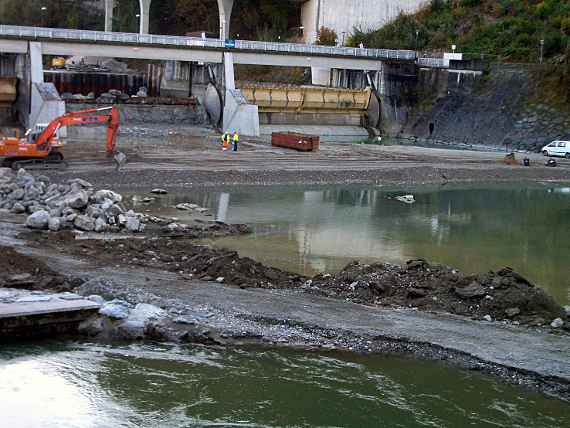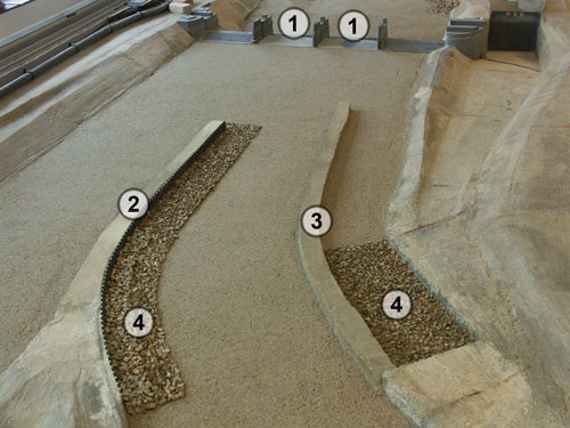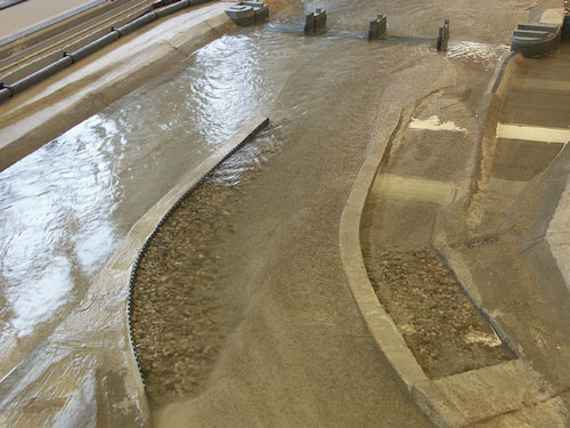For the city of Hallein (Salzburg) flood protection for HQ100 was not given. Bed-load accumulations in the area of the city of Hallein further aggravated the flood risk. Within the scope of this project, a solution was developed to improve the bed load discharge capacity at the Hallein power plant and to ensure HQ100 protection for Hallein in the future.
CUSTOMER: Salzburg AG (Special Projects - Structural Engineering Division) Project team: hydroconsult GmbH, Federal Office for Water Management - Institute for Hydraulic Engineering and Calibration of Hydrometrical Current-Meters (IWB).
In order to achieve the goals of improving flood protection and bed load removal, the following questions had to be answered:
- Improvement of bedload discharge during floods at the Hallein power plant by adapting the weir system in terms of bed morphology and hydraulics and by determining a favourable weir operation for bedload discharge into the tailwater of the power plant (preparation of a flushing strategy)
- Determination of the possible fluctuation range of the river bed from the tailwater to the Hallein power plant stage as a result of the bed load input from upstream and weir operation at the Hallein power plant stage. Thus, an upper limit for the HQ100 water level can be determined and a danger to the bank protection and bridge foundations can be avoided.
The determination of the range of fluctuation of the river bed posed a particular challenge for the modelling. Since every model, whether numerical or physical, can ultimately only represent the processes in nature with limitations, a possible range of fluctuation of the river bed should be worked out by combining several models. For this purpose, the hybrid modelling method, which is not yet common, was the obvious choice. Here, numerical and physical models are operated together and mutually the findings from the individual models are used. The following tools were intended for the planning:
- Simple bed load-hydraulic estimations concerning equilibrium slope and general morphology
- 1d bed-load transport models MORMO and Waspi-Hec 6 for general forecasts of the long-term behaviour of the river section between the two power plants
- 2d modelling of hydraulics and sediment transport (HYDRO_GS-2D)
- 3d morphology model SSIIM (3d flow and fractional bed load transport)
- Physical model starting upstream of the Perner Insel and ending downstream of the Hallein power plant (total length of the model 32 m)
Model space (background photo from google maps) with Pernerinsel; right arm with river mouth Alm = Kleine Salzach, left arm = Große Salzach
Results:
Optimized solution proposal, view in flow direction
The following measures, which can be seen in the picture "Optimized solution proposal", were proposed:
- lowering of the middle two weir fields by 2 m each. This corresponds to a lowering of all four weir fields of 1 m on average.
- extension of the island with a wall (bed load barrier), which separates the outflow of the two arms (Große and Kleine Salzach) up to a HQ10. This will reduce the backwater effect in the left arm (Große Salzach) and the bed load move better towards the weir. To reduce the effort for scour protection, the right side of the wall should be very rough.
- building another wall to keep the bedload away from the inlet to the turbines on the right side of the power plant.
- both walls need a scour protection made of large stones on the right side to prevent dangerous scourings. The reason for this is the redirection of the flow from the right arm towards the weir.
River bed at a discharge of 500 cubic meters per second after a HQ100 has previously flowed off, view in flow direction




